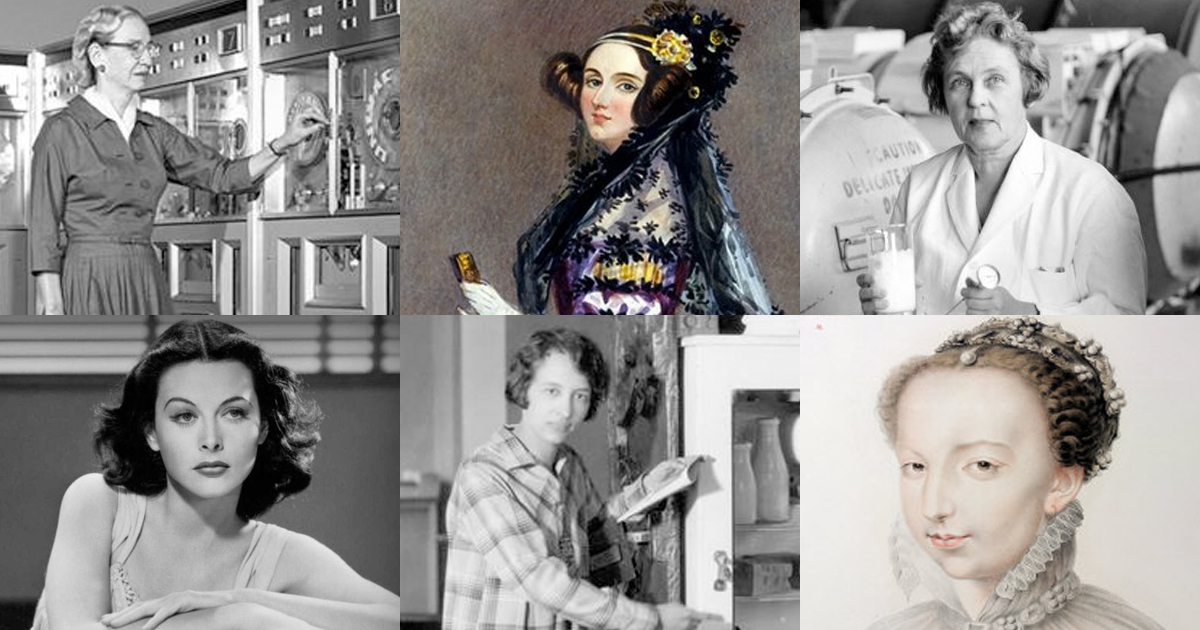Technology
Inventions By Women Through The Ages

Women have been at the forefront of a majority of inventions and discoveries throughout the ages. Breaking stereotypes and boundaries in all fields of work, women have made their mark in history and created a difference in the world. Let’s take a look at some of the inventions that would not have been possible without the help of strong and determined women.
Solar Heated Homes
One of the most prominent problems facing the society today is the need for alternative and renewable energy sources that can power a house, an office, a company and a city. In 1940, along with Eleanor Raymond, Dr. Maria Telkes solved this issue by inventing the first solar heated home. MIT researchers in the Department of Metallurgy, these women developed a home heated entirely by the sun, constructed for a sum of $20,000.
Computer Software
Women have ruled the science and technology world since the first computer was designed. Dr. Grace Hopper, a rear admiral in the US Navy, invented the first user friendly business computer software program and helped in designing Harvard’s Mark I computer, a five ton, room sized machine in 1944. She also coined the term ‘bug’ and ‘debugging’ when she had to remove moths from the device. She is also credited with inventing the compiler that translated written language into computer code and for designing COBOL, one of the first modern programming languages.
Computer Algorithm
The first computer programmer ever known, Ada Lovelace was inspired by Charles Babbage’s Analytical Engine. In 1842, she wrote an article describing the Analytical Engine by the Italian mathematician Luigi Menabrea with several early ‘computer programs,’ as well as strikingly prescient observations on the potential uses of the machine. Although she passed away at the young age of 36, her notes became one of the critical documents to inspire Alan Turing’s work on the first modern computers in the 1940s.
The Car Heater
Cars have become one of the most used means of transport. People living in the northern hemisphere can thank Margaret A. Wilcox who invented the first car heater in 1893. Her device directed warm air from over the engine to warm the chilly toes of the aristocratic 19th century motorists. Her design paved the way for other scientists to create improvised car heating systems commonly used today.
The Electric Refrigerator
It is easy to store food for days today because Florence Parpart invented the modern electric refrigerator in 1914. Parpart was a highly experienced entrepreneur who was successful in marketing and selling her refrigerators, developing her own advertisement campaigns and managing production operations of additional refrigerators.
While you cannot buy happiness, you can come pretty close to it, thanks to inventor Nancy Johnson. In 1843, Nancy invented and patented the ice cream freezer that is still used to the current day. The machine sold like hot cakes and within no time close to 70 improvements were made, making ice cream an affordable luxury and launching the ice cream industry.
Laying the foundation for WiFi and GPS technology used widely today, Hedy Lamarr proved that women can be much more than just a pretty face. During World War II, Hedy, who also happened to be a world famous film star, invented a secret communications system for radio controlling torpedoes which employed ‘frequency hopping technology,’ to create a signal that could not be intercepted. Despite having patented her idea, she signed it away to the Navy, never making a dime out of it.
Ever wondered how people in the old days would survive the cold harsh winters without any central heating? Central heating systems as we know of them today, would not have existed if not for Alice Parker’s idea to use natural gas to heat a personal home. In 1919, Alice invented a system of gas powered central heating which later on inspired the central heating systems of the future. Her invention revolutionized how people heat their homes and reduced the risk of high fires from the wood burnt in traditional furnaces.
Technology
Jio Unveils Cloud PC Service to Bring Affordable Computing to Indian Households

- Jio Platforms has launched JioPC, a cloud-based virtual desktop service that transforms any television connected to a Jio Set Top Box into a fully functional computer.
- Users simply connect a keyboard and mouse to access a desktop-like environment, complete with web browsing, productivity tools, and educational apps—all without needing a physical PC or extra hardware.
- The service is device-agnostic and works with all consumer PC brands, making advanced computing accessible and affordable for millions across India.
JioPC is designed to support a wide range of activities, from professional work to online learning and creative projects. By leveraging Jio’s robust cloud infrastructure, users can run even compute-intensive AI applications directly from their TV screens. The platform also ensures data security and reliability, as all files and settings are safely stored in the cloud, protecting users from data loss even if their device is reset or replaced.
With JioPC, Jio aims to democratize digital access and bring high-performance computing to Indian households at a fraction of the traditional cost. The service supports popular productivity suites like LibreOffice and Microsoft Office online, and Jio is offering a free trial to encourage users to experience the benefits firsthand. This innovative move is set to reshape how people in India work, learn, and connect in the digital age.
Technology
WhatsApp Introduces Ads in Updates Tab, Keeps Chats Ad-Free

Meta has officially begun rolling out ads on WhatsApp, ending over a decade of an ad-free experience since its acquisition in 2014. The advertisements will appear only in the Updates tab, specifically within the Status feature, which lets users share photos, videos, and text updates that disappear after 24 hours—similar to Instagram Stories.
Where Ads Will Appear
- Ads will be visible exclusively in the Status section of the Updates tab, keeping personal and group chats ad-free.
- Businesses can use these ads to encourage users to interact via WhatsApp messaging.
- Meta is also introducing paid channel subscriptions and promoted channels within the Updates tab, allowing users to access premium content and discover new channels more easily.
Privacy and Targeting
Meta has emphasized that private messages, calls, and group chats will remain end-to-end encrypted and free from advertising. Ads will be personalized using limited, non-sensitive data such as location, language, followed channels, and ad interactions. Users can further manage ad preferences if they link WhatsApp to Meta’s Accounts Center.
User and Business Impact
The move marks a major shift for WhatsApp, which has long resisted advertising to preserve a clean messaging experience. While some users have criticized the change, Meta sees this as a significant opportunity to monetize WhatsApp’s 3 billion users and over 200 million businesses on the platform.
In summary, WhatsApp’s new ads will be confined to the Updates tab, ensuring personal messaging remains private and uninterrupted, while opening new monetization avenues for Meta and businesses.
Technology
WhatsApp on iPad: The Long-Awaited Native Experience

After years of anticipation, WhatsApp has officially launched a dedicated app for the iPad, finally giving users a seamless and optimized messaging experience on Apple’s popular tablet. Previously, iPad users had to rely on the web version, which lacked many features and was not designed for the larger screen. Now, with the arrival of WhatsApp for iPad, users can enjoy all the core messaging and calling features in a native, iPadOS-optimized environment.
How to Get Started with WhatsApp on iPad
Setting up WhatsApp on your iPad is straightforward. Simply download the app from the App Store, open it, and scan the displayed QR code using your smartphone’s WhatsApp app to link your account. This process mirrors the setup for WhatsApp Web and Desktop, ensuring your chats, calls, and media stay in sync across devices. The iPad app supports all key features, including individual and group chats, Communities, Channels, and both audio and video calls for up to 32 participants.
Enhanced Features and Multitasking
WhatsApp for iPad is designed to take full advantage of the tablet’s capabilities. It features a two-column layout, with recent chats on the left and active conversations on the right, making multitasking easier and more intuitive. The app supports iPadOS multitasking features such as Split View, Slide Over, and Stage Manager (on compatible models), allowing users to keep WhatsApp open while using other apps. Additionally, it works seamlessly with accessories like the Magic Keyboard and Apple Pencil, boosting productivity and creativity.
Privacy and Security
All messages, calls, and media remain protected with WhatsApp’s industry-leading end-to-end encryption, ensuring privacy and security across all linked devices. The iPad app also includes privacy features like chat lock, giving users peace of mind even if they share their device with others.
Conclusion
The launch of WhatsApp on iPad marks a significant milestone for Meta and its users. With a native, feature-rich app designed for the iPad’s larger screen and advanced multitasking capabilities, WhatsApp is now more accessible and convenient than ever for iPad owners worldwide. This move also signals Meta’s commitment to expanding its ecosystem, with rumors suggesting Instagram may be next in line for a dedicated iPad app. For now, WhatsApp on iPad stands as a welcome upgrade, enhancing how millions stay connected.














Kuwin
November 6, 2025 at 3:25 am
kuwin sở hữu kho game đa dạng từ slot đến trò chơi bài đổi thưởng, mang đến cho bạn những giây phút giải trí tuyệt vời.
GO88
November 6, 2025 at 6:07 am
Tham gia cộng đồng game thủ tại Go88 để trải nghiệm các trò chơi bài, poker phổ biến nhất hiện nay.
站群程序
November 6, 2025 at 6:03 pm
搭载智能站群程序,自动化搭建与管理,为SEO项目提供核心驱动力。站群程序
ios超级签
November 8, 2025 at 1:54 pm
苹果签名,苹果超级签平台,ios超级签平台ios超级签苹果企业签,苹果超级签,稳定超级签名
MM88
November 9, 2025 at 2:00 pm
Với giao diện mượt mà và ưu đãi hấp dẫn, MM88 là lựa chọn lý tưởng cho các tín đồ giải trí trực tuyến.
站群程序
November 12, 2025 at 1:32 am
搭载智能站群程序,自动化搭建与管理,为SEO项目提供核心驱动力。站群程序
iwin
November 13, 2025 at 5:05 am
iwin – nền tảng game bài đổi thưởng uy tín, nơi bạn có thể thử vận may và tận hưởng nhiều tựa game hấp
J88
November 21, 2025 at 8:30 pm
Đến với J88, bạn sẽ được trải nghiệm dịch vụ cá cược chuyên nghiệp cùng hàng ngàn sự kiện khuyến mãi độc quyền.
MM88
November 22, 2025 at 11:43 am
Khám phá thế giới giải trí trực tuyến đỉnh cao tại MM88, nơi mang đến những trải nghiệm cá cược thể thao và casino sống động.